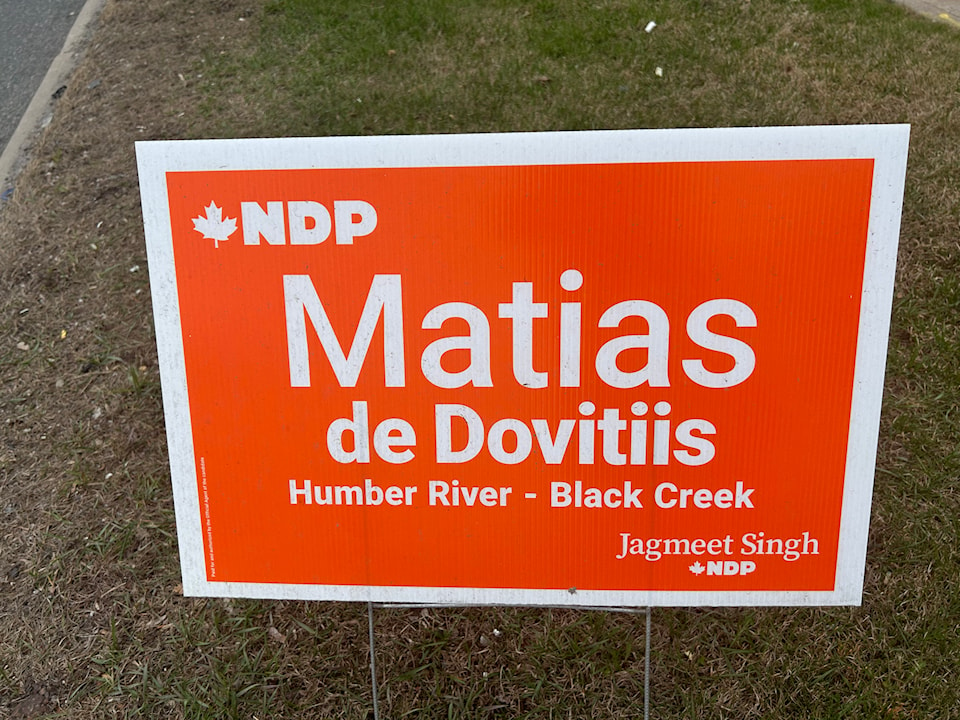The polls are not looking good for the New Democratic Party. Its support is vanishing on the national scene.
Nanos' recent polls have seen a consistent drop in NDP voters, garnering less than nine per cent in mid-April. At dissolution, the NDP had 25 seats, but current polls suggest that, at best, the party may get only seven this election.
NDP Leader Jagmeet Singh is even projected to lose his seat in Burnaby Central in British Columbia.
Dimitry Anastakis, a historian and professor from the Department of Political Science at the University of Toronto, said the Liberals appear to be siphoning off NDP supporters as the party's fortunes collapse.
Anastakis said the 905 Region of the Greater Toronto Region, having so many seats, often determines an election's outcome.
He said there is a historical trend where Ontarians usually have one party in power in Queen’s Park and a different party in Ottawa’s Parliament Hill.
Anastakis said this was also a contributing factor to Doug Ford’s early election because at the time, it looked like the Liberals were going down to defeat.
Michael J. Wigginton, a part-time instructor at the University of Ottawa and a postdoctoral fellow at Carleton University, said the biggest issue now is the U.S. with a “fractured relationship with Trump,” and Canadians do not want to bet on a third party.
“We’re also seeing similar things happen with the Bloc Québécois and to a lesser extent with the Greens, but they never had a particularly large vote share,” Wigginton said.
He said the Bloc is also at risk of losing a lot of its seats in the upcoming election.
Wigginton said it is very difficult for the NDP to distinguish themselves now, considering that’s a risk they ran during the supply and confidence agreement between them and the Liberals. The arrangement allowed Justin Trudeau's minority government to receive the support of one or more parties for confidence votes and the budget.
He said this made NDP align with the Trudeau government on many policy fronts.
“There’s not a lot of daylight between them in terms of their platforms, which makes it harder for the NDP to now say that, okay, but you should be voting for us this time around and not the Liberals,” Wigginton said.
He said people don’t vote strategically as much.
“People kind of overstate how much of a factor it is, partly because most people don’t have such strong party preferences, but when they do, the party they like the best is usually the one they end up voting for,” Wigginton said.
He said NDP voters, seeing the party slip in the polls, might not vote for them, thinking it would let the Conservatives win, so they end up voting for the Liberals, which puts the NDP in an increasingly bad situation.
Wigginton said Singh affects the direction that the party is choosing to take.
“There is an argument to be made that at a certain point, leaders just wear out their welcome, that is the usual conventional wisdom, at least, that at a certain point, people just want change,” he said.
Wigginton gives examples of wartime elections and Quebec separation referenda.
“When you have these big issues that dominate the election like that for parties that might be focused on other things, it becomes much more difficult to get attention and to get voters interested in your policies,” he said.
Wigginton said it is very late in the election process for the NDP to change their leader, but it could potentially help them.
He said sometimes changing a leader is an easy way to signal a change, something that happened with the Liberals, which allowed them to make a policy pivot.
Wigginton said there is a good chance that in this election, the NDP's leader might not win his seat.
“At least the last polling projections I looked at, there’s a good chance the NDP are going to lose a lot of their seats in British Columbia. So, it’s not clear that come the next parliament, Jagmeet Singh will be an MP,” he said.
Wigginton said they are really at risk and there is a decent chance they might fall below the 12 seats needed to maintain official party status.
He said this might additionally hurt the party because once they lose their party status, they also lose the additional funding they get for parliamentary purposes throughout the parliament.
“You also get much more access to speaking time in parliament, the ability to introduce bills, and so if they fall below that threshold of 12, it will really hamper their ability to do well for future elections,” Wigginton said.
He said it would make things harder as they would not have the same resources, they would not be able to put many private members’ bills forward or even get many questions during question period.
“There’s a chance that both they [NDP] and the Bloc will fall below the (party status) threshold,” Wigginton said.
He said the New Democrats are likely to be focused on key ridings instead of trying to gain new ground, and that Singh is probably going to try to keep his seat.
If Singh loses his seat, the party may begin its quest to replace its leader since 2017.
“Rachel Notley, I would say that the possibility of her becoming leader, I don’t think she speaks French, and so I don’t think it’s particularly likely she would become the federal NDP leader,” he said.
Notley, the former leader of the Alberta NDP who also served as premier, retired from the leadership role in 2024.



